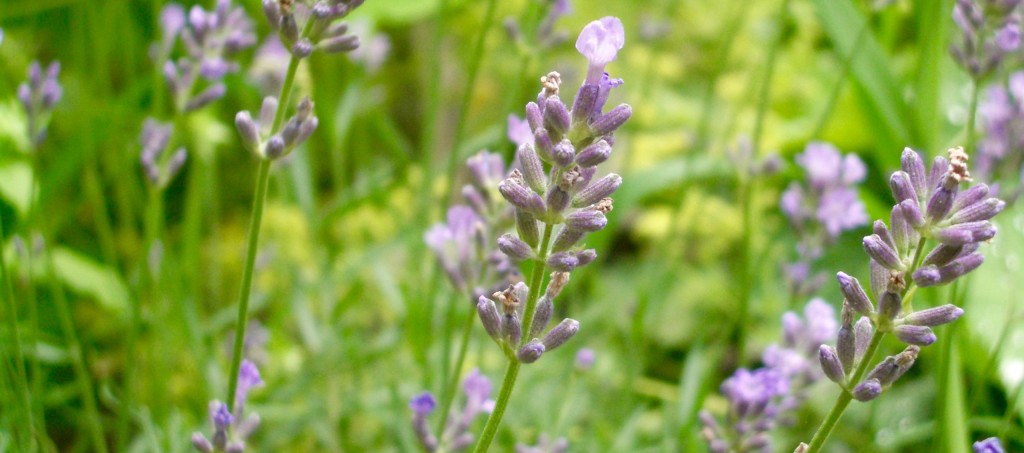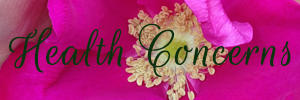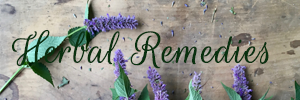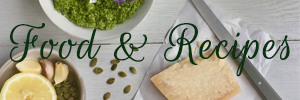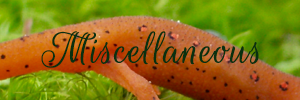Herbal Healing on the Go! ~
No home is complete without some kind of first aid kit. Stashing a kit in the linen closet, car, purse, or suitcase provides a little extra security no matter where you are. It’s easy and invaluable to incorporate herbs and natural remedies into your kit, but it’s still only useful if you actually have what you need in an emergency. Before you compile your kit, first ask yourself some questions so you can create the most useful kit for your family.
Location & Shelf Life: Your home kit has the most flexibility because you have plenty of space, good storage conditions (cool, dark, dry cabinets and closets), and even access to a refrigerator. But if you plan to stash your kit in the car, you’ll need something smaller with remedies that can withstand the elements. Water-based liquids will freeze and break containers. Oil-based remedies go rancid quickly in a hot car, salves will melt, alcohol might explode (unlikely but could happen at 170°F or higher, depending on the proof), and dry herbs and teas will get cooked to oblivion. Tinctures work well for car kits because they will last for a few years and the combination of alcohol and water makes them unlikely to freeze or explode. If you’re traveling or always carrying your kit, just bring the bare bones necessities and nothing that requires refrigeration. When I go on 120-mile kayak/portage treks, I carry just a few tiny bottles and think creatively about what wild plants I can use in a pinch. Keep small servings of your most-needed remedies in your purse. For kits-to-go, keep 1/4- and 1/2-ounce dropper and spray bottles on hand for easy packing and administering. I prefer glass, but plastic may work better in some situations. Poke around herb shops and online (or break out your sewing equipment) for cute cloth carriers that hold bottles so they’re unlikely to break, or just wrap the bottles and store in Ziplock baggies or reusable silicone bags like these ones with sliders, which are a bit more secure, or these zip-style ones from Stasher. (If you don’t, something’s sure to break or leak!) Individually wrapped products from the natural food store are great for first aid kits: tea bags, herbal candies, homeopathic remedies, electrolyte and magnesium packets, natural antiseptic wipes, blister packs of probiotics and other natural remedies, etc. Homeopathic remedies are also perfect for first-aid kits.
What You Will Need: Where are you going, and what will you need? When I traveled to Guatemala, I knew my normally rock-solid digestion would be challenged. I packed shelf-stable probiotics, hard ginger candies (which held up to the heat and humidity better than chewy candies and crystallized ginger), ginger capsules, and electrolyte packets. But if you’re packing for summer vaca with kids, remedies for bumps, bruises, wounds, splinters, bug bites, and poison ivy will more likely be in order. Think about what kinds of ailments are most likely to pop up for your family in a variety of situations, and stash remedies where you think you’ll need them. It’s easy to go nuts and pack everything under the sun… only to have it all go unused and get tossed a year or two later when it’s out of date.
Multitask: When possible, choose remedies with more than one purpose. For example,
lavender essential oil helps with almost any topical ailment you can think of: rashes, itchy skin, infections, burns, general sanitization, repelling bugs, etc. (Store-bought lavender wipes work in a pinch, but the straight essential oil also works well.) The scent of lavender also aids anxiety and insomnia. Echinacea/goldenseal/propolis throat spray does double-duty for topical infections. Lemon balm tincture (made with fresh leaves) helps heal cold sores externally while soothing nerves and digestion internally. Kava tincture works across the board for most adults with anxiety or insomnia. For children, go for chamomile, which also helps with indigestion and teething. I keep homemade calendula and St. John’s wort salve in lip balm tubes for itchy rashes, diaper rashes, wound healing, and hemorrhoids; remove salve from the tube with your finger or a cloth so you can use one tube for multiple purposes without contaminating it.
The Basics:
Almost every first aid kit should include the following. Pick the one(s) that you prefer and work best for your family.
- Anti-nausea: Ginger candies, crystallized ginger, and peppermint candy or gum quell motion sickness, morning sickness, and nausea from cancer treatments. Gum’s handy for airplanes because it helps keep the air pressure from building in the ears.
- Antiseptic, Disinfectant & Wound Healer: Lavender and/or tea tree essential oil, essential oil wipes (ie: lavender, tea tree, oregano, or thyme), echinacea/goldenseal “throat” spray, or Kloss’ liniment can help with a variety of skin infections and may also soothe itches. Alcohol and vinegar can disinfect. Raw honey cleans and heals wounds. Comfrey heals/seals skin very quickly but does not disinfect and shouldn’t be used on deep or infected wounds. Seek medical attention if an infection continues to worsen or doesn’t get better within 24 hours.
- Pain Reliever: Powdered magnesium (mixed in water) helps with muscle pain, spasms,headaches, and migraines. White willow bark acts as a mild, natural aspirin. Turmeric and ginger help relieve inflammation. I make my own “loose muscles” tincture with a variety of herbal pain relievers including pedicularis, California poppy, and small amounts of corydalis, wintergreen, and birch. Look for pain formulas at the herb shop or natural food store, too. Arnica homeopathic tabs for bumps, bruises, and accident-related trauma or over-use aches. But, be sure ahead of time that the remedy actually works for your family. Natural pain remedies are finicky, milder than conventional NSAIDs, and some may cause mild stomach upset
- Sedative: Chamomile for children. For adults, try kava has the broadest, fastest action, but also consider valerian, skullcap, lemon balm, or passionflower to help induce sleep and calm anxiety. Also consider flower essences like Bach’s Rescue Remedy or FES’s Five Flower Formula, which can be used topically and internally for stress, anxiety, trauma, and rashes.
- Standard Supply: Bandages, tweezers, thermometer, etc. I still keep Benadryl and ibuprofen on hand, just in case. If you’ll be somewhere warm, don’t forget the natural bug spray and sunscreen.
Extra First Aid Remedies for Common Ailments:
Definitely don’t feel like you should have ALL these remedies. Only stock for ailments that tend to afflict your family (or that you anticipate with travel), and choose a remedy or two that best works for your family from the options. Unless specified, most of the herbs can be used internally as teas, tinctures, or capsules; or externally as an herb-infused oil, salve, poultice, or wash.
Topical First Aid (External use unless specified)
- Bumps & Bruises: Arnica (not on broken skin), gotu kola, Rescue Remedy. Rescue Remedy, gotu kola, and homeopathic arnica tabs can also be taken internally. Homemade comfrey leaf infused oil is also great.
- Rashes, Poison Ivy, Bug Bites: Lavender and/or tea tree essential oil or wipes, calendula oil or salve, plantain poultice or oil/salve. Apple cider vinegar, jewelweed, or grindelia specifically ease poison ivy rashes.
- Infections: Berberine-rich plants (organically cultivated goldenseal, coptis, barberry, Oregon grape root, such as in a throat spray or Kloss’ liniment), oregano/bee balm, yarrow leaf, lavender, honey. Chaparral and thuja leaves are particularly helpful for fungal infections.
- Blisters: Apply under a bandage or overnight: almost any salve (calendula, lavender, plantain…), plantain poultice, honey.
- Hemorrhoids: Calendula oil or salve, witch hazel, yarrow.
- Sunburns & Burns: St. John’s wort oil can prevent and treat, lavender essential oil, apple cider vinegar, calendula, fresh-cut and applied aloe or cactus pad, cool green tea, self heal, or chaparral wash, ice or cool water.
- Herpes: Lemon balm tincture (internally and externally) or cream, St. John’s wort oil, licorice powder, cayenne/capsaicin oil or salve (will burn at first, don’t get in eyes or on genitals). Calming herbs internally.
- Splinters & Stings: Remove splinters with sterilized tweezers or needle or attempt to draw out with clay paste, plantain poultice, pine/fir pitch, or ripe banana peel. Plantain is specific for stings and other bites. Consider echinacea tincture topically and internally if there is concern of infection (classic remedy for snake bite) or apply a berberine-rich remedy and then apply a compress of aloe for the day. Of course, get to the hospital immediately if there is a severe reaction, dangerous bite, or significant infection. I combine equal parts plantain leaf oil and yarrow tincture and shake vigorously before applying to bug bites — easy and often quite effective!
- Topical Pain: St. John’s wort oil relieves nerve pain including rashes, burns, and sciatica. Arnica or Rescue Remedy for trauma and bruising. Cayenne salve or cream for many types of pain including arthritis (will burn at first, don’t get in eyes or on genitals). Diluted wintergreen essential oil has aspirin-like effects, and peppermint essential oil/menthol serves as a counter-irritant and pain reliever.
Digestive Distress
- Gas, Pain & Bloating: Peppermint (especially internal essential oil preparations), fennel seeds, cardamom, probiotics, digestive enzymes.
- Constipation: Yellow dock root, Triphala, Smooth Move or senna tea (short-term only), digestive bitters (milder), probiotics.
- Diarrhea: Cinnamon, carob, electrolyte packets, miso soup, probiotics.
- Nervous Indigestion & Colic: Chamomile, catnip, lemon balm.
- Indigestion: Peppermint, balm tea, chamomile or catnip tea, ginger, vinegar, digestive bitters, digestive enzymes, nervous indigestion remedies.
- Acid Reflux, Heartburn & Ulcers: Licorice or DGL tablets, aloe gel (inner gel only, not whole leaf), marshmallow root overnight infusion or powder mixed with water or oatmeal, Throat Coat tea, plantain. I personally love to combine oat milk (like Oatly) with the overnight marshmallow root infusion, perhaps with some maple syrup and a pinch of nutmeg – it tastes great and is very soothing. Comfrey leaf tea can heal digestive wounds quickly but may also be liver toxic and is not generally recommended for internal use. Ulcers will still require medical attention. For reflux and heartburn caused by poor/weak digestion, vinegar, ginger, bitters, and spices are fabulous, but these are all contraindicated in acute ulcers and gastritis.
- Food Poisoning: Activated charcoal capsules in particular, betonite clay, cinnamon powder, beberine-rich plants. For support: probiotics, ginger, electrolyte fluids, miso soup, fermented foods.
Pain
- Headaches & Migraines: Magnesium powder (in water) or butterbur/Petadolex help prevent and stave off an oncoming headache or migraine. Feverfew helps preventively. Kava can help in a pinch for tension headaches. Coffee may stop an early migraine. (Regular coffee and NSAID use will ultimately cause withdrawal/rebound headaches and migraines.)
- Aches & Pains: Turmeric, ginger, tart or black cherry, boswellia, magnesium, bromelain or fresh pineapple juice. Also see pain relievers in “Basics” and topical pain relievers.
- Menstrual Cramps: Cramp bark (tincture is best, taken every 15 minutes) is the most widely effective. Also ginger, cinnamon, dong quai, magnesium, apply heat.
- Gout: Tart or black cherry juice/extract, celery juice, celery ribs. (Best taken regularly.)
Stress, Insomnia & Anxiety
- Energy: Caffeine works quickly and temporarily; green tea, chocolate, and yerba mate are my preferred forms. Adaptogen herbs have better energy benefits over time. For more stimulating energy, try rhodiola, ginseng, and/or eleuthero. For calm energy, try holy basil, gotu kola, milky oat seed, and/or bacopa. In the middle, try schizandra and/or ashwagandha.
- Anxiety & Insomnia: See Sedatives in “The Basics.” For sleep, especially while traveling, try an eye mask and ear plugs.
Infections
- Cold: Elder syrup, ginger, echinacea, umckaloabo (Umcka), andrographis, garlic, chicken or miso soup, cayenne, rest.
- Flu: Elder syrup, rest, hot teas (or tincture added to hot water) of ginger, elder flower, yarrow, boneset, and/or peppermint to break a sweat.
- Sore Throat: Echinacea/goldenseal/propolis throat spray, raw garlic, honey, lemon, oregano/bee balm, ginger, elder syrup, echinacea, slippery elm, Throat Coat tea, salt gargles or salty broth.
- Throat Coat tea does double duty to soothe throats and acid reflux. True licorice candies may also help.
- Sinus: Salt wash/neti, berberine-rich plants, goldenrod, horehound, or herbal steams with thyme, eucalyptus, peppermint, and/or oregano/bee balm herbs or essential oils.
- Cough: Honey, wild cherry bark syrup, horehound, elder syrup, menthol candies.
- Plain honey – preferably raw – does a nice job for sore throats, coughs, AND as a topical remedy to disinfect and heal wounds.
- Allergies: Horehound, goldenrod, nettle, quercetin, bromelain, eyebright and berberine-rich plants, specific homeopathic remedies.
- UTI: Cranberry juice, blueberry juice, blueberry leaf tea, uva ursi, juniper berries. Also watch your sugar and alcohol intake. Stop using the herbs and see a doctor immediately if it moves into the kidneys (lower back pain, fever, cloudy urine).
This is a BIG LIST. Remember: Try to pick just 5-10 of your own top-need items that your family likes best, for example…
Here’s a sample Travel Kit that I put together for a recent return trip to Italy:
- Elderberry Syrup – To bolster my immune system (planes, lack of sleep, and visiting four children – oh my!), soothe sore throats, quell coughs. Should’ve brought more! This was surprisingly difficult to find for resupply in spite of an Erboristeria (herb shop) in every town. I make my own with dried herbs, but many brands are available in stores.
- Calendula Salve – For itchy, dry skin issues like rashes, cracks on my feet, dry skin… also good for diaper rash, hemorrhoids, etc. Click here for tips on DIY oils and salves.
- Lavender Essential Oil – For almost anything topical. Great to mix in with the calendula salve before applying. For essential oil tips and cautions, click here.
- Lavender Wipes – For almost anything topical, including quick hand sanitation.
- Valerian Tincture – My go-to for sleep (as well as an eye mask and earplugs). Click here for how to make your own tinctures.
- Cramp Bark – For menstrual cramps, unfortunate timing.
- Ionic Fizz Cal-Mag Packets – To keep my muscles and bones happy during hill hikes and long days of walking around the city. Natural Calm is also popular, but I tend to prefer Ionic Fizz if you can find it.
- Gin Gins Hard Ginger Candies – Almost ran out of these on a winding drive up to Cortona – it’s amazing none of the kids (nor I) puked!
- Ibuprofen and Benadryl (just in case), bandaids, tweezers.
Click here to learn how to make your own remedies.
Clinical herbalist Maria Noël Groves sees clients and teaches classes at Wintergreen Botanicals Herbal Clinic & Education Center in Allenstown, New Hampshire.
The statements made on this blog have not been evaluated by the FDA and are not intended to diagnose, prescribe, recommend, treat, cure, or offer medical advice. Please see your health care practitioner for help regarding choices and to avoid herb-drug interactions.
This blog originally appeared on the Concord Food Co-op site and has been reprinted with permission.
Amazon links are affiliate links – I will make a small percent if you purchase via these links, but I’m recommending the items because they’re actually what I use and love.

